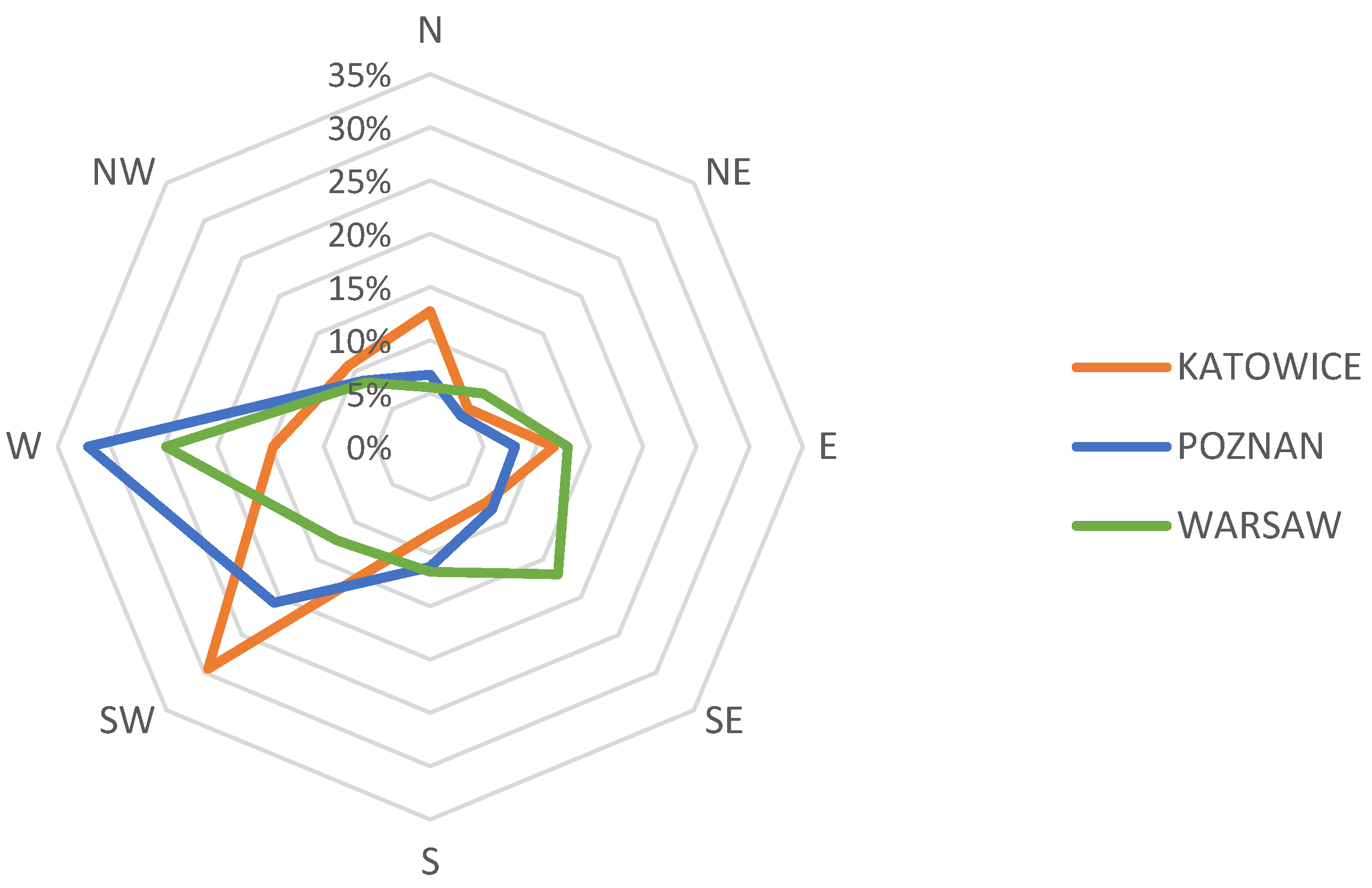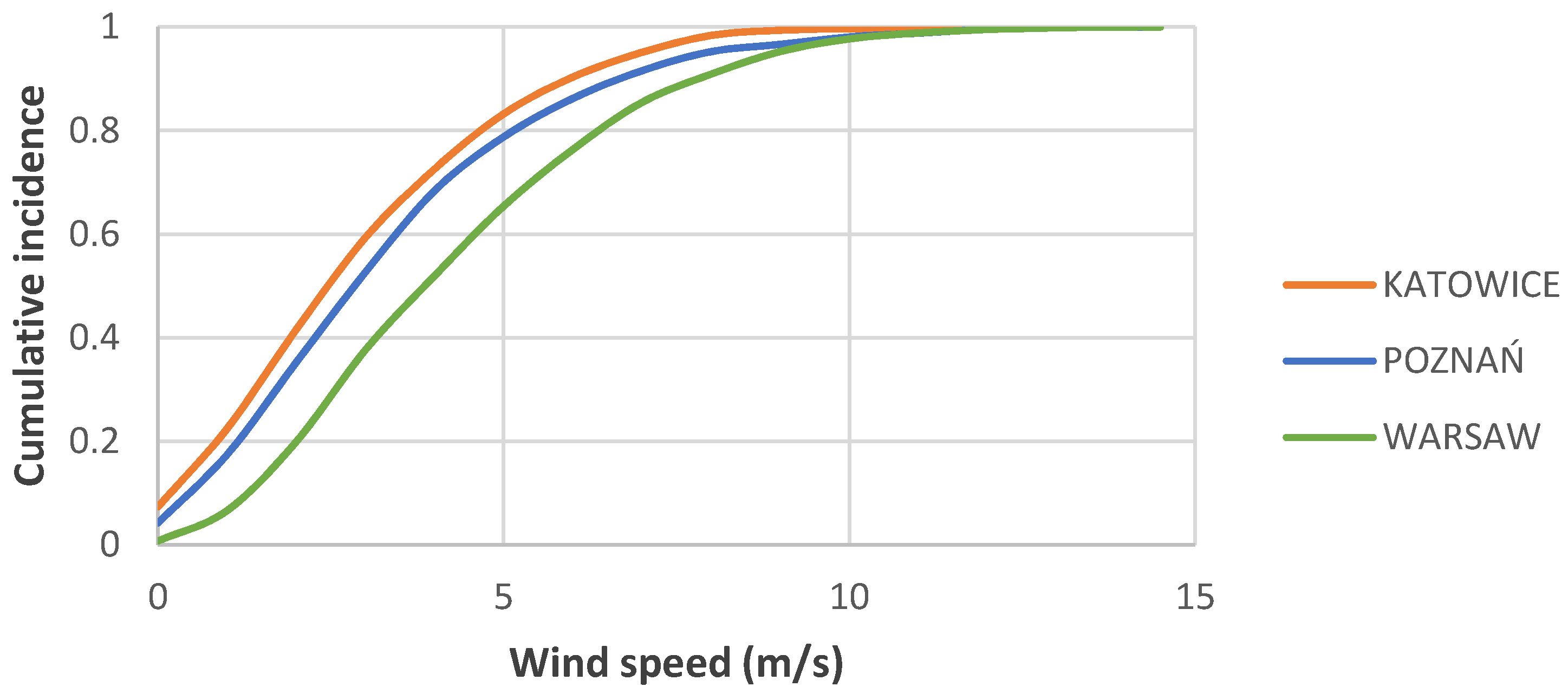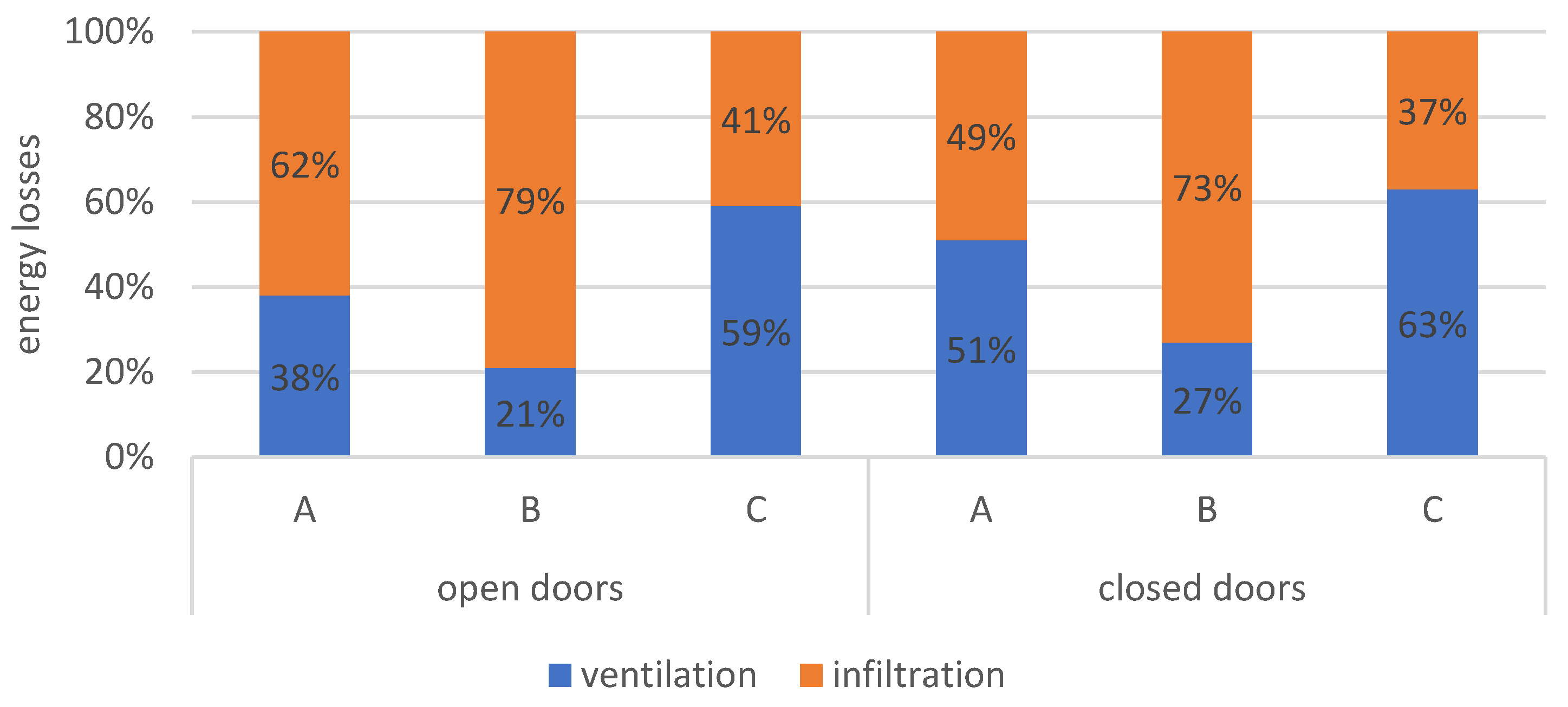Parametric Study of Air Infiltration in Residential Buildings—The Effect of Local Conditions on Energy Demand
Abstract
:1. Introduction
2. Airtightness Requirements—The Current State
- Type of ventilation system (natural, hybrid, mechanical, and in some cases heat recovery), e.g., Czech Republic and Latvia; In the case of gravity ventilation, the tightness of the building, depending on the country, should meet the condition n50 < 2.4–4.5 h−1 for new buildings and n50 < 3.6 h−1 for buildings subject to modernization. More stringent requirements apply to buildings with mechanical ventilation, where n50 < 1.5–2.0 h−1 for new buildings and n50 < 2.4 h−1 for buildings undergoing modernization.
- Type of residential building (single or multi-family), e.g., France;
- Building condition (new or refurbished), e.g., Switzerland and Liechtenstein;
- Energy efficiency, e.g., Lithuania;
- Climatic zone, e.g., USA;
- Relationship between different geometrical properties, e.g., Denmark and Spain;
- Guidelines describing the air barrier, e.g., Canada.
3. Building Types, Weather Data, and Local Conditions
3.1. Building Types and Construction
3.2. Local Weather Conditions
3.3. Building Exposure
- bare (open area, e.g., agricultural area) k = 1.0 (unsheltered),
- moderately sheltered (wooded area or surrounded by buildings of similar height, e.g., city suburbs) k = 0.8 (semi-sheltered),
- sheltered (area surrounded by buildings higher than the analyzed building, e.g., city centers) k = 0.5 (sheltered).
4. Air Flow Modelling and Calibration
- Building A, n50 = 1.50 h−1
- Building B, n50 = 1.78 h−1
- Building C, n50 = 0.63 h−1
5. The Effect of Weather Data and Local Conditions on Simulation Results
5.1. The Effect of Local Conditions on Infiltrating Air Flow
- Airstreams infiltrating through leaks;
- The energy required to heat up the ventilation and infiltration air.
5.2. The Effect of Wind Speed and External Temperature on Energy Demand
6. Discussion and Conclusions
Author Contributions
Funding
Institutional Review Board Statement
Informed Consent Statement
Data Availability Statement
Acknowledgments
Conflicts of Interest
References
- Etheridge, D. A perspective on fifty years of natural ventilation research. Build. Environ. 2015, 91, 51–60. [Google Scholar] [CrossRef]
- Erhorn-Kluttig, H.; Erhorn, H.; Lahmidi, H.; Anderson, R. Airtightness requirements for high performance building envelopes. In Proceedings of the 4th Intern. Symposium on Building and Ductwork Air tightness 30th AIVC Conference “Trends in High Performance Buildings”, Berlin/Germany, Germany, 1–2 October 2009. [Google Scholar]
- Miszczuk, A. Influence of air tightness of the building on its energy-efficiency in single-family buildings in Poland. In Proceedings of the XXVI R-S-P Seminar 2017 Theoretical Foundation of Civil Engineering, Warsaw, Poland, 21–25 August 2017; Volume 117. [Google Scholar]
- Weston, T.; Nelson, K.; Wissink, K. Whole Building Air Leakage: Testing and Building Performance Impacts; ASTM International: West Conshohocken, PA, USA, 2019; ISBN 978-0-8031-7676-8. [Google Scholar]
- Poza-Casado, I.; Cardoso, V.E.M.; Almeida, R.M.S.F.; Meiss, A.; Ramos, N.M.M.; Padilla-Marcos, M.Á. Residential buildings airtightness frameworks: A review on the main databases and setups in Europe and North America. Build. Environ. 2020, 183, 107221. [Google Scholar] [CrossRef]
- Han, G.; Srebric, J.; Enache-Pommer, E. Different modeling strategies of infiltration rates for an office building to improve accuracy of building energy simulations. Energy Build. 2015, 86, 288–295. [Google Scholar] [CrossRef]
- Younes, C.; Shdid, C.A.; Bitsuamlak, G. Air infiltration through building envelopes: A review. J. Build. Phys. 2011, 35, 267–302. [Google Scholar] [CrossRef]
- Allen, E.; Thallon, R.; Schreyer, A.C. Fundamentals of Residential Construction, 4th ed.; John Wiley & Sons: Hoboken, NJ, USA, 2017. [Google Scholar]
- Raman, G.; Chelliah, K.; Prakash, M.; Muehleisen, R.T. Detection and quantification of building air infiltration using remote acoustic methods. In Proceedings of the Inter-Noise 2014, Melbourne, Australia, 16–19 November 2014; p. 10. [Google Scholar]
- Emmerich, S.J.; Persily, A.K. Energy impacts of infiltration and ventilation in U.S. office buildings using multizone airflow simulation. IAQ Energy 1998, 98, 191–203. [Google Scholar]
- Jokisalo, J.; Kurnitski, J.; Korpi, M.; Kalamees, T.; Vinha, J. Building leakage, infiltration, and energy performance analyses for Finnish detached houses. Build. Environ. 2009, 44, 377–387. [Google Scholar] [CrossRef]
- Sowa, J. Creation of the indoor environment in office buildings. ASHRAE J. 2020, 62, 64–68. [Google Scholar]
- Piasecki, M.; Kostyrko, K. Development of weighting scheme for indoor air quality model using a multi-attribute decision making method. Energies 2020, 13, 3120. [Google Scholar] [CrossRef]
- Crawley, J.; Wingfield, J.; Elwell, C. The relationship between airtightness and ventilation in new UK dwellings. Build. Serv. Eng. Res. Technol. 2018, 40, 274–289. [Google Scholar] [CrossRef] [Green Version]
- Ala-Kotila, P.; Vainio, T.; Laamanen, J. The influence of building renovations on indoor comfort—A field test in an apartment building. Energies 2020, 13, 4958. [Google Scholar] [CrossRef]
- Kisilewicz, T.; Nowak-Dzieszko, K.; Rojewska-Warchał, M. Influence of building airtightness on the internal thermal comfort and air quality in the single family house. In Proceedings of the IOP Conference Series: Materials Science and Engineering, 10th International Conference IAQVEC 2019: Indoor Air Quality, Ventilation and Energy Conservation in Buildings, Bari, Italy, 5–7 September 2019; Volume 609, p. 032064. [Google Scholar]
- Firlag, S. Cost-optimal plus energy building in a cold climate. Energies 2019, 12, 3841. [Google Scholar] [CrossRef] [Green Version]
- Miszczuk, A. The Level of Airtightness in Energy-efficient Single-family Houses in Poland. Procedia Eng. 2016, 153, 461–466. [Google Scholar] [CrossRef] [Green Version]
- Kwiatkowski, J.; Sowa, J.; Trząski, A.; Wiszniewski, A. Dormitory thermal retrofitting to nZEB standard. IOP Conf. Ser. Mater. Sci. Eng. 2018, 415, 12002. [Google Scholar] [CrossRef]
- Shrestha, P.M.; Humphrey, J.L.; Barton, K.E.; Carlton, E.J.; Adgate, J.L.; Root, E.D.; Miller, S.L. Impact of low-income home energy-efficiency retrofits on building air tightness and healthy home indicators. Sustainability 2019, 11, 2667. [Google Scholar] [CrossRef] [Green Version]
- Basińska, M.; Koczyk, H. Analysis of the possibilities to achieve the low energy residential buildings standards. Technol. Econ. Dev. Econ. 2016, 22, 830–849. [Google Scholar] [CrossRef]
- Górzeński, R.; Szymański, M.; Górka, A.; Mróz, T. Airtightness of Buildings in Poland. Int. J. Vent. 2014, 12, 391–400. [Google Scholar] [CrossRef]
- Kalamees, T. Air tightness and air leakages of new lightweight single-family detached houses in Estonia. Build. Environ. 2007, 42, 2369–2377. [Google Scholar] [CrossRef]
- Ahmed, K.; Carlier, M.; Feldmann, C.; Kurnitski, J. A new method for contrasting energy performance and near-zero energy building requirements in different climates and countries. Energies 2018, 11, 1334. [Google Scholar] [CrossRef] [Green Version]
- Hamdy, M.; Hasan, A.; Siren, K. A multi-stage optimization method for cost-optimal and nearly-zero-energy building solutions in line with the EPBD-recast 2010. Energy Build. 2013, 56, 189–203. [Google Scholar] [CrossRef]
- Global Wind Atlas 3.0. A Free, Web-Based Application Developed, Owned And Operated By The Technical University Of Denmark (DTU). Available online: https://globalwindatlas.info/ (accessed on 20 November 2020).
- Wang, J.-W.; Yang, H.-J.; Kim, J.-J. Wind speed estimation in urban areas based on the relationships between background wind speeds and morphological parameters. J. Wind Eng. Ind. Aerodyn. 2020, 205, 104324. [Google Scholar] [CrossRef]
- Allegrini, J.; Lopez, B. The influence of angular configuration of two buildings on the local wind climate. J. Wind Eng. Ind. Aerodyn. 2016, 156, 50–61. [Google Scholar] [CrossRef]
- Jamińska-Gadomska, P.; Lipecki, T.; Pieńko, M.; Podgórski, J. Wind velocity changes along the passage between two angled walls—CFD simulations and full-scale measurements. Build. Environ. 2019, 157, 391–401. [Google Scholar] [CrossRef]
- Montazeri, H.; Blocken, B.; Derome, D.; Carmeliet, J.; Hensen, J.L.M. CFD analysis of forced convective heat transfer coefficients at windward building facades: Influence of building geometry. J. Wind Eng. Ind. Aerodyn. 2015, 146, 102–116. [Google Scholar] [CrossRef] [Green Version]
- Hadavi, M.; Pasdarshahri, H. Quantifying impacts of wind speed and urban neighborhood layout on the infiltration rate of residential buildings. Sustain. Cities Soc. 2020, 53, 101887. [Google Scholar] [CrossRef]
- Feng, C.; Gu, M.; Zheng, D. Numerical simulation of wind effects on super high-rise buildings considering wind veering with height based on CFD. J. Fluids Struct. 2019, 91, 102715. [Google Scholar] [CrossRef]
- Carpentieri, M.; Robins, A.G. Influence of urban morphology on air flow over building arrays. J. Wind Eng. Ind. Aerodyn. 2015, 145, 61–74. [Google Scholar] [CrossRef] [Green Version]
- Klemm, K.; Marks, W.; Klemm, A.J. Multicriteria optimisation of the building arrangement with application of numerical simulation. Build. Environ. 2000, 35, 537–544. [Google Scholar] [CrossRef]
- Khoshdel Nikkho, S.; Heidarinejad, M.; Liu, J.; Srebric, J. Quantifying the impact of urban wind sheltering on the building energy consumption. Appl. Therm. Eng. 2017, 116, 850–865. [Google Scholar] [CrossRef] [Green Version]
- Narowski, P.; Janicki, M.; Heim, D. Comparison of untypical meteorological years (umy) and their influence on building energy performance simulations. In Proceedings of the BS 2013: 13th Conference of the International Building Performance Simulation Association, Chambéry, France, 26–28 August 2013; pp. 1414–1421. [Google Scholar]
- Pernigotto, G.; Walsh, A.; Gasparella, A.; Hensen, J.L.M. Clustering of European Climates and Representative Climate Identification for Building Energy Simulation Analyses. In Proceedings of the 16th IBPSA Conference, Rome, Italy, 2–4 September 2019; pp. 4833–4840. [Google Scholar]
- Kottek, M.; Grieser, J.; Beck, C.; Rudolf, B.; Rubel, F. World map of the Köppen-Geiger climate classification updated. Meteorol. Z. 2006, 15, 259–263. [Google Scholar] [CrossRef]
- Cóstola, D.; Blocken, B.; Hensen, J.L.M. Overview of pressure coefficient data in building energy simulation and airflow network programs. Build. Environ. 2009, 44, 2027–2036. [Google Scholar] [CrossRef] [Green Version]
- Sherman, M.H.; Chan, W.R. Building Airtightness: Research and Practice. In State of the Art in Ventilation; James & James: London, UK, 2003; pp. 8–12. [Google Scholar]
- Zheng, X.; Mazzon, J.; Wallis, I.; Wood, C.J. Airtightness measurement of an outdoor chamber using the Pulse and blower door methods under various wind and leakage scenarios. Build. Environ. 2020, 179, 106950. [Google Scholar] [CrossRef]
- Sobolewski, A.; Żurański, J.A. Zasoby energetyczne wiatru w Polsce. Biul. Inf. IBMER 1981, 1/204, 70–83. [Google Scholar]
- Flaga, A. Wind Engineering; Arkady: Warszawa, Poland, 2008. [Google Scholar]
- Heim, D.; Miszczuk, A. Modelling building infiltration using the airflow network model approach calibrated by air-tightness test results and leak detection. Build. Serv. Eng. Res. Technol. 2020, 41, 681–693. [Google Scholar] [CrossRef]
- Monari, F.; Strachan, P. Characterization of an airflow network model by sensitivity analysis: Parameter screening, fixing, prioritizing and mapping. J. Build. Perform. Simul. 2017, 10, 17–36. [Google Scholar] [CrossRef] [Green Version]
- Clarke, J.A.; Kelly, N.J.; Tang, D. A Review of ESP-r’s Flexible Solution Approach and its Application to Prospective Technical Domain Developments. Adv. Build. Energy Res. 2007, 1, 227–247. [Google Scholar] [CrossRef]











| Parameter | Description | Equation | Unit |
|---|---|---|---|
| na | air change rate at a Pa | Va/V | h−1 |
| wa | specific leakage rate at a Pa | Va/AE | m3/h∙m2 |
| qa | air permeability rate at a Pa | Va/AF | m3/h∙m2 |
| Country | Parameter | Units | Requirements |
|---|---|---|---|
| Airtightness mandatory values | |||
| Austria | n50 | h−1 | natural ventilation < 3.0 mechanical ventilation < 1.5 |
| Belgium–Brussels region | n50 | h−1 | <0.6 |
| Bosnia | n50 | h−1 | natural ventilation < 3.0 mechanical ventilation < 1.5 |
| Croatia | n50 | h−1 | natural ventilation < 3.0 mechanical ventilation < 1.5 |
| Czech Republic | n50 | h−1 | natural ventilation < 4.5 mechanical ventilation < 1.5 heat recovery system < 1.0 |
| Denmark | w50 | l/(s⋅m2) | Aenv/Afloor ≤3: <1.0 Aenv/Afloor >3: <0.3 |
| France | q4 | m3/(h⋅m2) | single-family < 0.6 multi-family < 1.0 |
| Germany | n50 | h−1 | natural ventilation < 3.0 (exceptions with active components < 1.5) mechanical ventilation < 1.5 |
| Iceland | q50 | m3/(h⋅m2) | <3 |
| Ireland | q50 | m3/(h⋅m2) | <5 |
| Latvia | q50 | m3/(h⋅m2) | natural ventilation < 3.0 mechanical ventilation < 2.0 heat recovery system < 1.5 |
| Liechtenstein | q50 | m3/(h⋅m2) | new buildings:
|
| Lithuania | n50 | h−1 | class C: < 2.0 class B: < 1.5 class A: < 1.0 class A+ and A++: < 0.6 |
| Luxembourg | n50 | h−1 | natural ventilation < 3.0 mechanical ventilation < 1.5 heat recovery system < 1.0 |
| Monaco | q4 | m3/(h⋅m2) | single-family < 0.6 multi-family < 1.0 |
| Montenegro | n50 | h−1 | natural ventilation < 3.0 mechanical ventilation < 1.5 |
| Netherlands | w10 | dm3/(s⋅m2) | <1.0 |
| Norway | n50 | h−1 | <1.5 |
| Russia | n50 | h−1 | natural ventilation < 4.0 mechanical ventilation < 2.0 |
| Slovenia | n50 | h−1 | natural ventilation < 3.0 mechanical ventilation < 2.0 |
| Spain | n50 | h−1 | compacity V/AE ≤2: <6.0 V/AE ≥4: <3.0 |
| Sweden | q50 | m3/(h⋅m2) | <0,6 |
| Switzerland | q50 | m3/(h⋅m2) | new buildings:
|
| United Kingdom | q50 | m3/(h⋅m2) | <10 |
| USA | n50 | h−1 | <3.0 climate zone 3 to 8 <5.0 climate zone 1 and 2 |
| Airtightness recommended values | |||
| Poland | n50 | h−1 | natural ventilation < 3.0 mechanical ventilation < 1.5 |
| Airtightness default values that can be improved | |||
| Belgium (Flanders and Wallonia) | q50 | m3/(h⋅m2) | 12 |
| Canada | n50 | h−1 | 3.2 with basic air barrier specifications 2.5 with extra prescriptive details |
| Estonia | q50 | m3/(h⋅m2) | single-family: 6.0 other buildings: 3.0 |
| Finland | q50 | m3/(h⋅m2) | 4.0 |
| No whole building values suggested or no consideration at all | |||
| Albania, Andorra, Belarus, Bulgaria, Cyprus, Greece, Hungary, Italy (except Trento and Bolzano regions), Malta, Moldova, North Macedonia, San Marino, Serbia, Ukraine, Portugal, and Slovakia. | |||
| Building | A | B | C |
|---|---|---|---|
| n50 (h−1) | 1.50 | 1.78 | 0.63 |
| Building | A | B | C | ||||
|---|---|---|---|---|---|---|---|
| Air Stream | Seasonal Total (m3/Season) | Seasonal Average (m3/h) | Seasonal Total (m3/Season) | Seasonal Average (m3/h) | Seasonal Total (m3/Season) | Seasonal Average (m3/h) | |
| ventilation | 621,600 | 140 | 576,000 | 160 | 568,800 | 100 | |
| infiltration | internal door open | 105,713 | 23.8 | 229,884 | 63.9 | 46,476 | 8.2 |
| internal door closed | 60,844 | 13.7 | 160,876 | 44.7 | 38,675 | 6.8 | |
| total summary | internal door open | 727,313 | 163.8 | 805,884 | 223.9 | 615,276 | 108.2 |
| internal door closed | 682,444 | 153.7 | 736,876 | 204.7 | 607,475 | 106.8 | |
| Type of Building Environment | Factor k (-) | Infiltrating Air Stream (m3/h) | |||
|---|---|---|---|---|---|
| Building B | Building C | ||||
| Katowice | Warsaw | Katowice | Warsaw | ||
| unsheltered | 1.0 | 65.7 | 100.6 | 5.8 | 10.7 |
| medium-sheltered | 0.8 | 46.6 | 70.5 | 4.1 | 7.4 |
| sheltered | 0.5 | 23.9 | 34.5 | 2.2 | 3.6 |
| Building | A | B | C | |
|---|---|---|---|---|
| heat for ventilation (kWh) | 387.3 | 368.6 | 337.6 | |
| heat for infiltration (kWh) | internal door open | 640.6 | 1 399.8 | 233.2 |
| internal door closed | 370.3 | 985.5 | 197.5 | |
| total heat for ventilation and infiltration (kWh) | internal door open | 1 027.9 | 1 768.4 | 570.8 |
| internal door closed | 757.6 | 1 354.1 | 535.1 | |
| Location | Katowice | Warsaw | |
|---|---|---|---|
| heat for ventilation (kWh) | 385 | 397 | |
| heat for infiltration (kWh) | unsheltered building | 1497 | 2311 |
| medium-sheltered building | 1068 | 1 626 | |
| sheltered building | 554 | 808 | |
| total heat for ventilation and infiltration (kWh) | unsheltered building | 1882 | 2708 |
| medium-sheltered building | 1453 | 2023 | |
| sheltered building | 939 | 1205 | |
| Location | Katowice | Warsaw | |
|---|---|---|---|
| heat for ventilation (kWh) | 326 | 338 | |
| heat for infiltration (kWh) | unsheltered building | 157 | 300 |
| medium-sheltered building | 114 | 209 | |
| sheltered building | 60 | 101 | |
| total heat for ventilation and infiltration (kWh) | unsheltered building | 483 | 638 |
| medium-sheltered building | 440 | 547 | |
| sheltered building | 386 | 439 | |
Publisher’s Note: MDPI stays neutral with regard to jurisdictional claims in published maps and institutional affiliations. |
© 2020 by the authors. Licensee MDPI, Basel, Switzerland. This article is an open access article distributed under the terms and conditions of the Creative Commons Attribution (CC BY) license (http://creativecommons.org/licenses/by/4.0/).
Share and Cite
Miszczuk, A.; Heim, D. Parametric Study of Air Infiltration in Residential Buildings—The Effect of Local Conditions on Energy Demand. Energies 2021, 14, 127. https://doi.org/10.3390/en14010127
Miszczuk A, Heim D. Parametric Study of Air Infiltration in Residential Buildings—The Effect of Local Conditions on Energy Demand. Energies. 2021; 14(1):127. https://doi.org/10.3390/en14010127
Chicago/Turabian StyleMiszczuk, Artur, and Dariusz Heim. 2021. "Parametric Study of Air Infiltration in Residential Buildings—The Effect of Local Conditions on Energy Demand" Energies 14, no. 1: 127. https://doi.org/10.3390/en14010127
APA StyleMiszczuk, A., & Heim, D. (2021). Parametric Study of Air Infiltration in Residential Buildings—The Effect of Local Conditions on Energy Demand. Energies, 14(1), 127. https://doi.org/10.3390/en14010127






